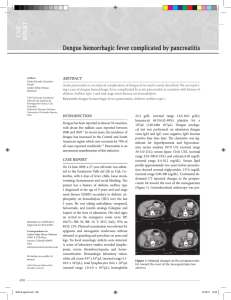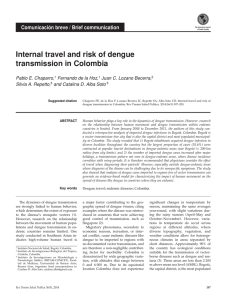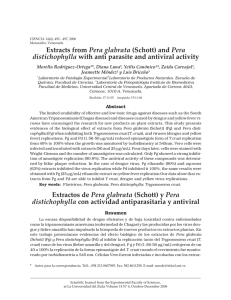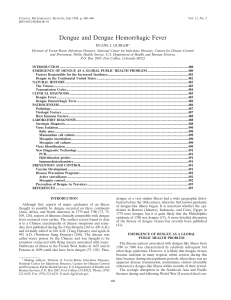Dengue Situation in Bolivia
Anuncio
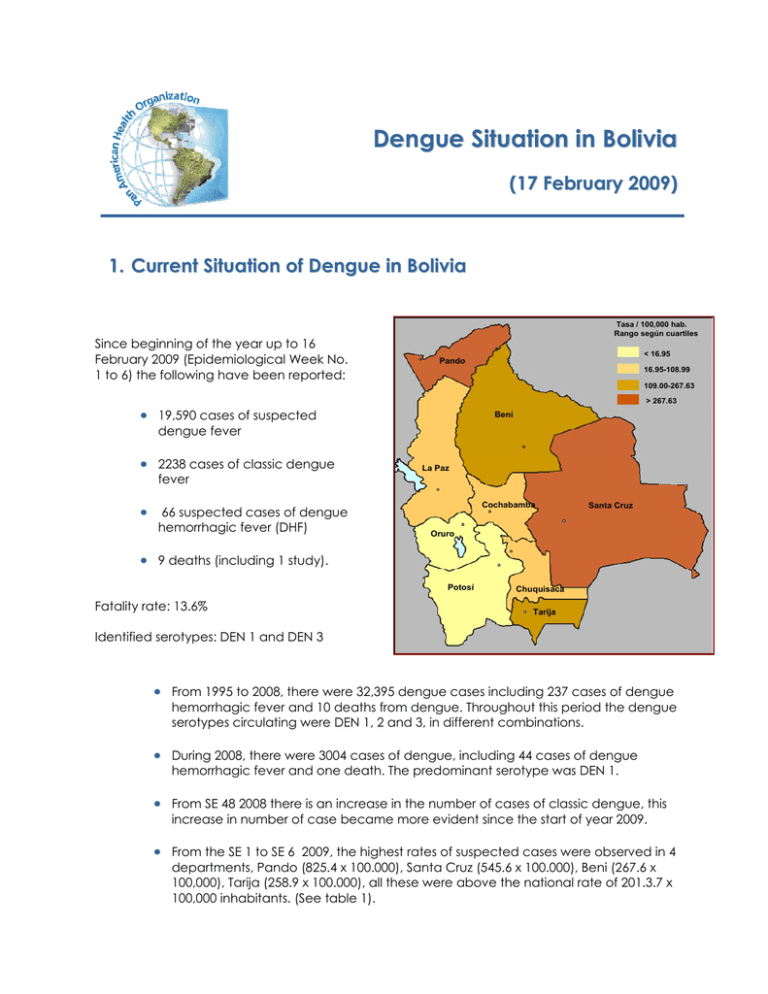
Dengue Situation in Bolivia (17 February 2009) 1. Current Situation of Dengue in Bolivia Since beginning of the year up to 16 February 2009 (Epidemiological Week No. 1 to 6) the following have been reported: Tasa / 100,000 hab. Rango según cuartiles < 16.95 Pando 16.95-108.99 109.00-267.63 > 267.63 • 19,590 cases of suspected Beni dengue fever • 2238 cases of classic dengue fever La Paz • 66 suspected cases of dengue hemorrhagic fever (DHF) Cochabamba Santa Cruz Oruro • 9 deaths (including 1 study). Potosí Fatality rate: 13.6% Chuquisaca Tarija Identified serotypes: DEN 1 and DEN 3 • From 1995 to 2008, there were 32,395 dengue cases including 237 cases of dengue hemorrhagic fever and 10 deaths from dengue. Throughout this period the dengue serotypes circulating were DEN 1, 2 and 3, in different combinations. • During 2008, there were 3004 cases of dengue, including 44 cases of dengue hemorrhagic fever and one death. The predominant serotype was DEN 1. • From SE 48 2008 there is an increase in the number of cases of classic dengue, this increase in number of case became more evident since the start of year 2009. • From the SE 1 to SE 6 2009, the highest rates of suspected cases were observed in 4 departments, Pando (825.4 x 100.000), Santa Cruz (545.6 x 100.000), Beni (267.6 x 100,000), Tarija (258.9 x 100.000), all these were above the national rate of 201.3.7 x 100,000 inhabitants. (See table 1). Table No 1. Dengue notification and rates according case classification, by department. Bolivia SE 1 a SE 6, 2009 DEPARTMENT SUSPECT cases Rate x 100.000 hab1 . CONFIRMED cases DHF Deaths probable cases BENI 1110 267.63 60 1 0 COCHABAMBA 1862 108.90 236 9 2 CHUQUISACA 407 66.54 72 3 0 LA PAZ 487 16.95 116 1 1 13865 585.65 1629 48 5 PANDO 574 825.41 0 2 0 TARIJA 1221 258.93 107 1 0 ORURO 55 12.58 17 1 1 POTOSI 9 1.16 1 19590 201.39 2238 SANTA CRUZ National Total 0 66 9 Source: Epidemiology Unit, MSD and SNIS. Ministry of Health and Sports, Bolivia. • With regard to the circulating serotypes, still dominate the DEN-1 and DEN-3. • To date there are 9 deaths reported due to hemorrhagic dengue (case-fatality rate of 13.6%), one of which is still under investigation. Deaths correspond to two adults, 3 teenagers and 4 children. The 55% of deaths are in children under 12 years. • The outbreak continues with a predominance of classic dengue. 2. Prevention and Control Activities Underway a. Local-Level Activities Santa Cruz de la Sierra • House to house visits for treatment and destruction of breeding sites is being carried out with the participation of about 80 municipal workers and 200 members of the armed forces. According to data from SEDES there were 65,000 houses visited, equivalent to 19% of the municipality. It is important to intensify such actions but more personnel will be needed. • According to the situation analysis, it was decided to concentrate efforts in districts 6, 7 and 8 to intensify the actions of entomological and epidemiological 1 * Population proyections from INE 2006. 2 surveillance; these districts registered the highest transmission. About 200 people will work continuously in the destruction of breeding sites there. • Similar activities are underway in other priority departments. 3. PAHO Support • In December 2008, national experts, with support from the International Dengue Task Force (GT-Dengue) and PAHO/WHO, prepared the Integrated Strategy for Dengue Prevention and Control (EGI-Dengue) in Bolivia. At that time, the country also developed its EGI-Dengue Contingency Plan to Respond to Dengue Outbreaks and Epidemics, which served as a basis for the measures taken during the current outbreak. • In the area of Aedes aegypti control, the PAHO/WHO entomology expert is advising staff from the National Center for Tropical Diseases (Centro Nacional de Enfermedades Tropicales / CENETROP), with the objective of providing support to surveillance and control activities. Seventeen persons will be working on municipal stratification to implement the strategy of Rapid Survey of Aedine Indices (Levantamiento de Índices Aédicos Rápido / LIRAa) in the four Urban Area Health Networks (Redes de Salud del Área Urbana). In addition, support is being provided to coordinate the purchase of fumigation equipment and pesticides. • There is a better flow of information due to the activation of the situation room, which is coordinated jointly by the national technical team and OPS. • The provision of equipment for the situation rooms to strengthen the management of public health information continues. • The PAHO / WHO Dengue Regional Adviser, Dr. Jose Luis San Martin is now in Bolivia for the continuation of the technical support to the country. • Based on the current situation and the priorities identified, a proposal for the re orientation of the technical cooperation plan was developed. Data source: Epidemiology Unit, MSD and SNIS. Ministry of Health and Sports, Bolivia. 3
